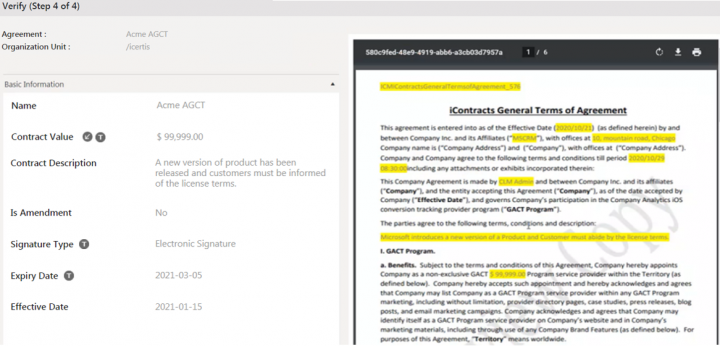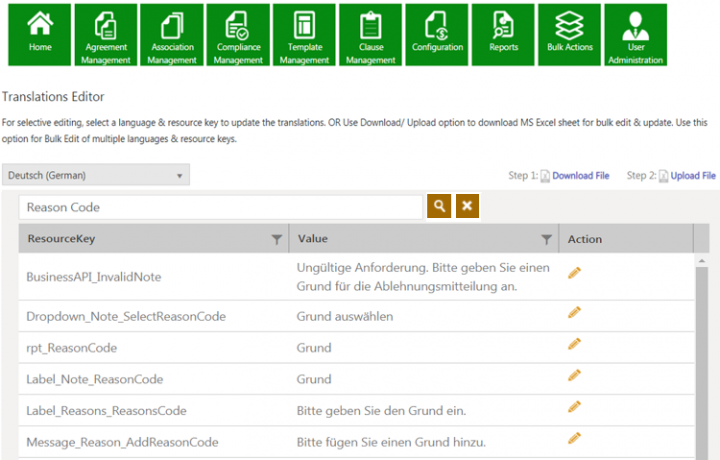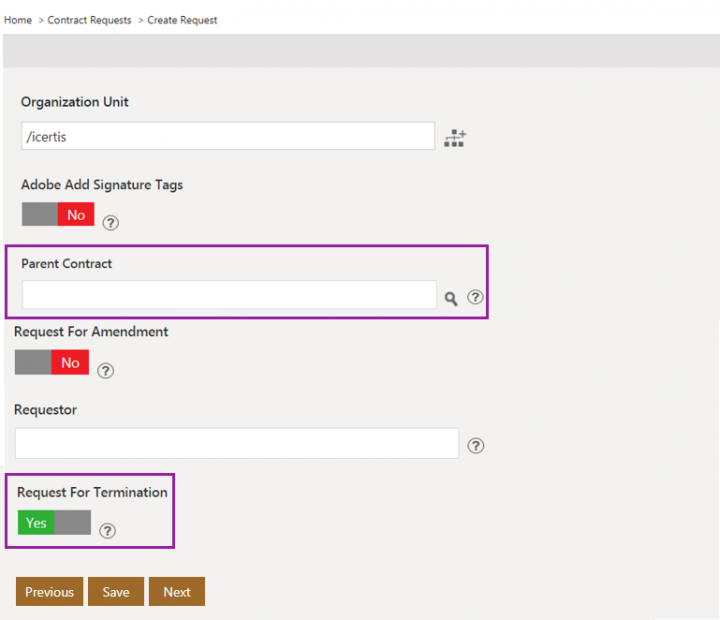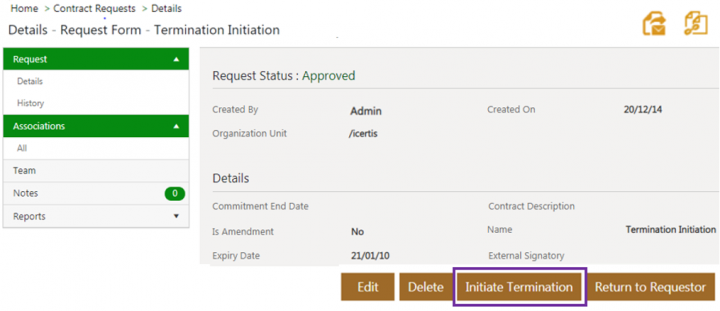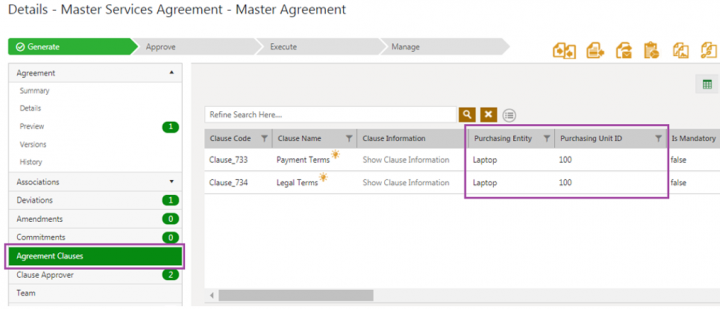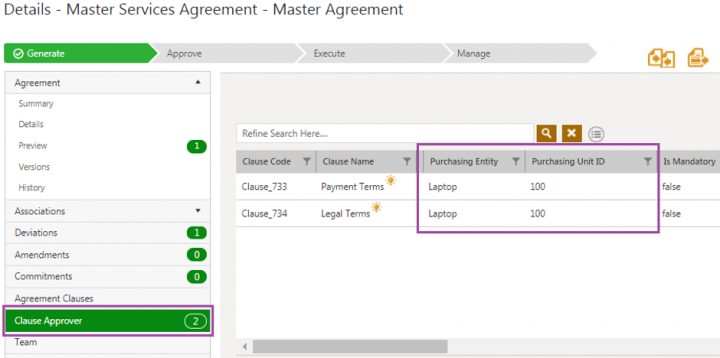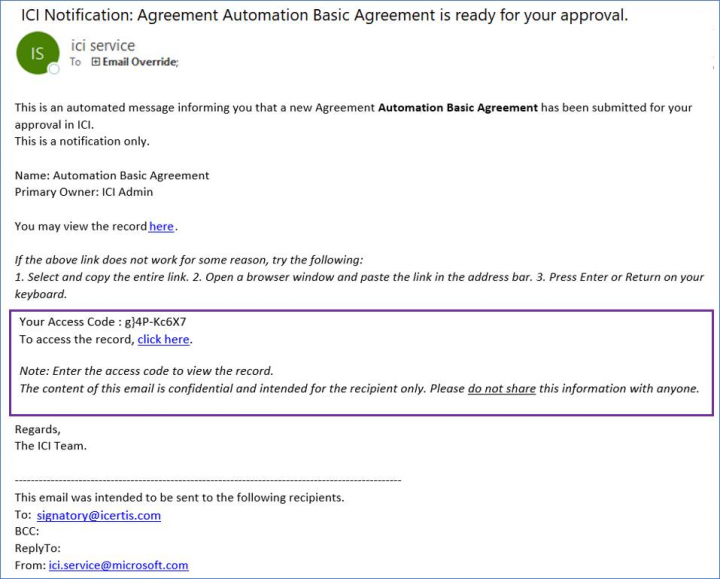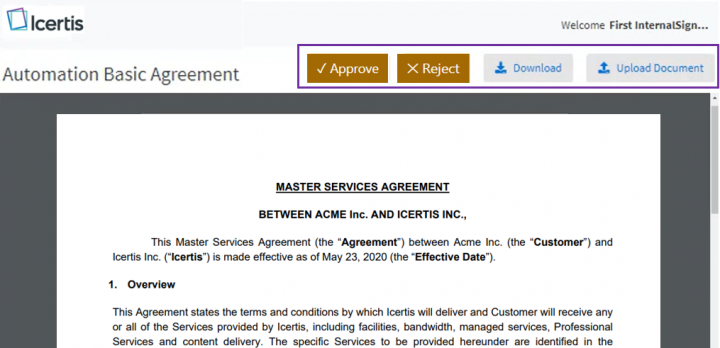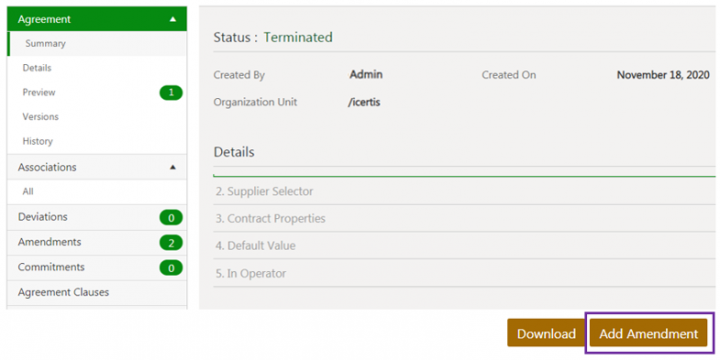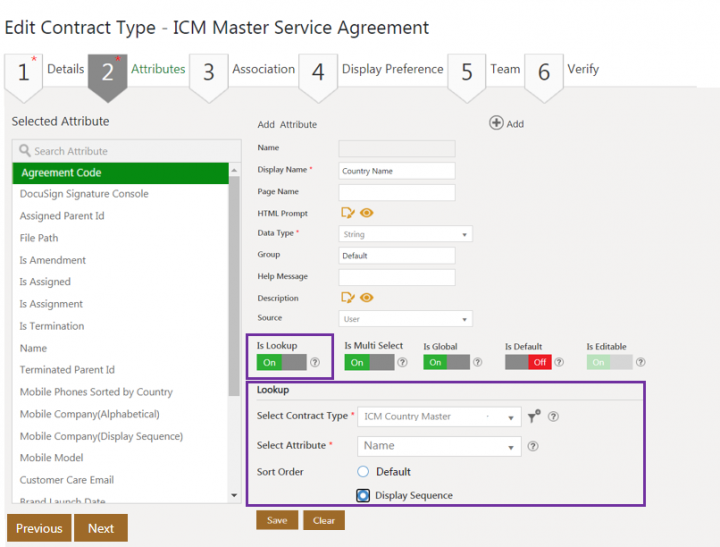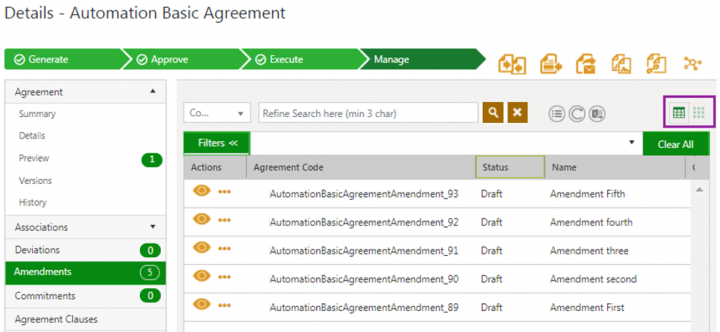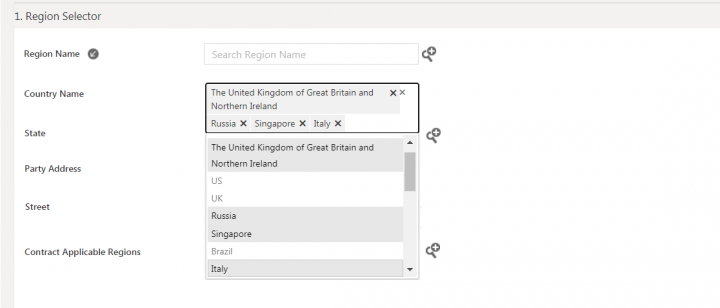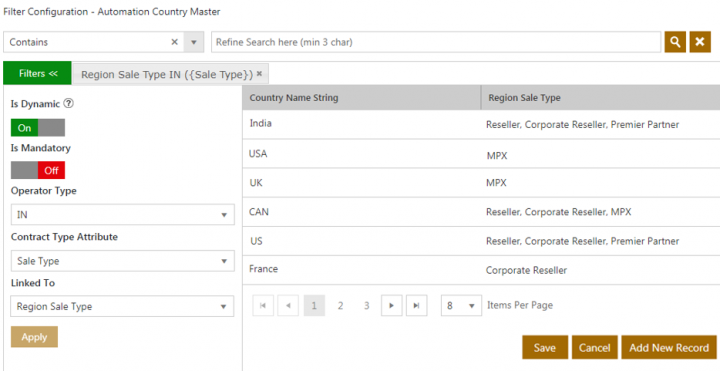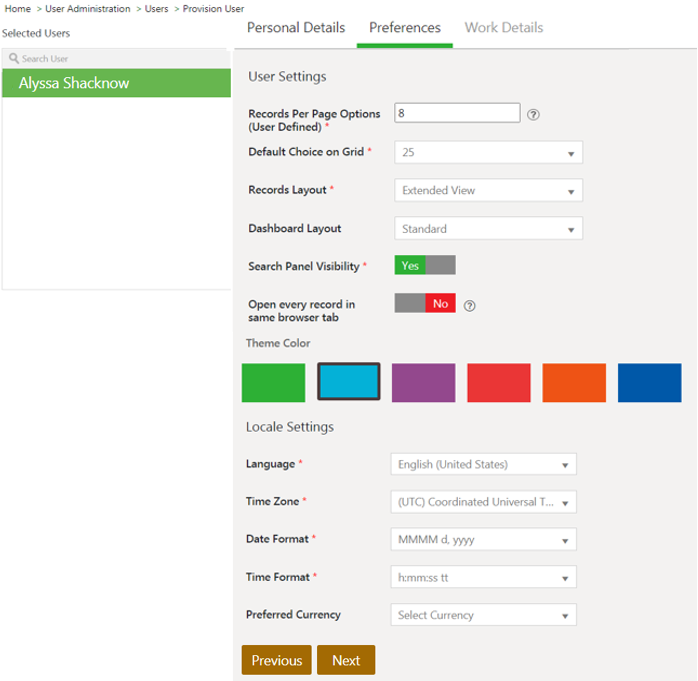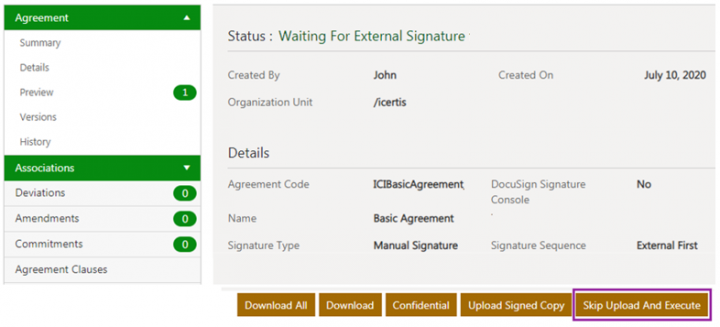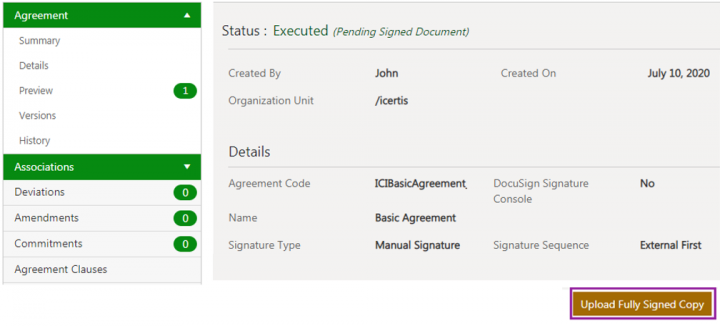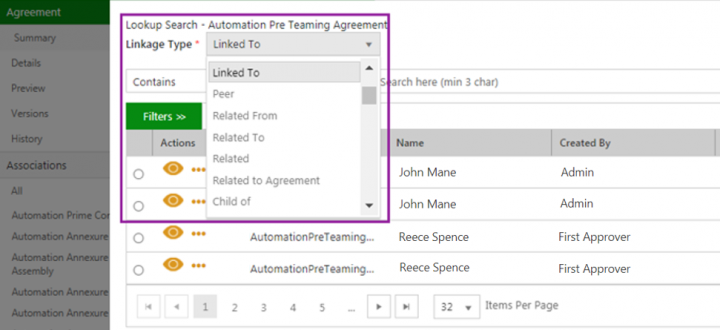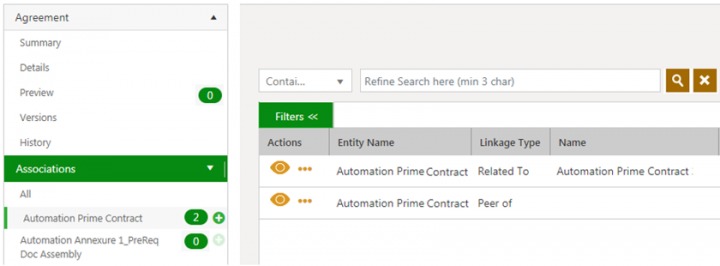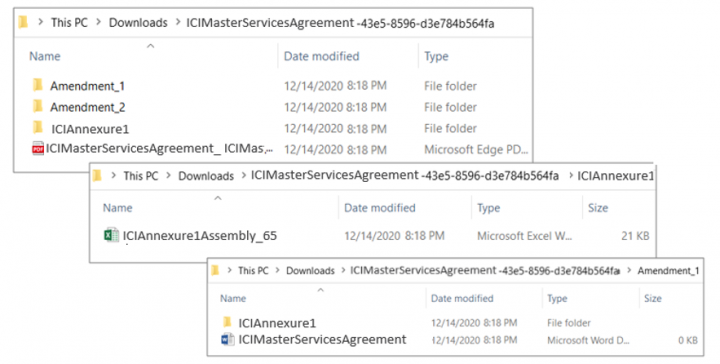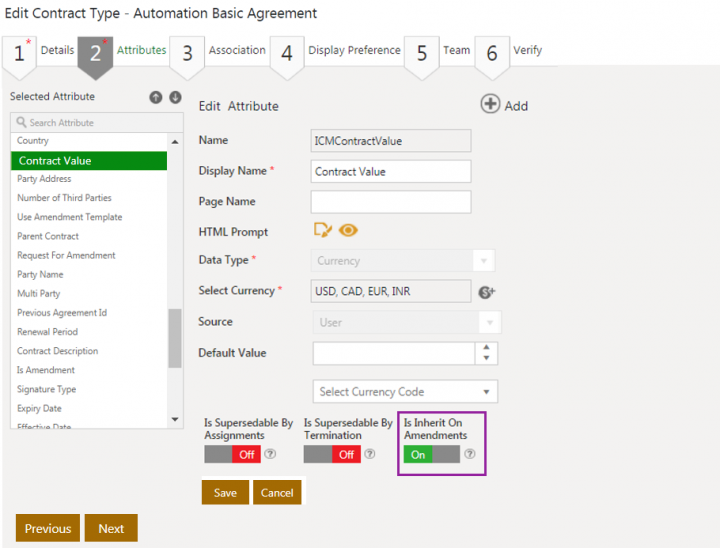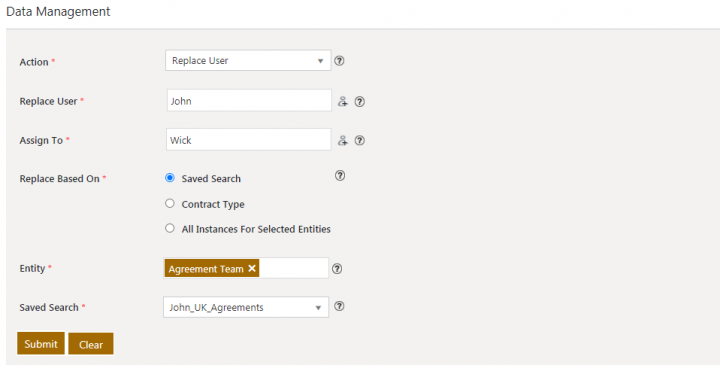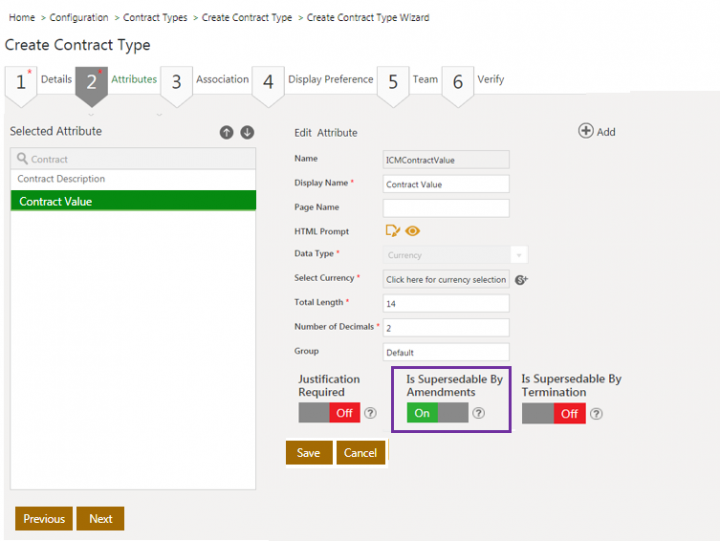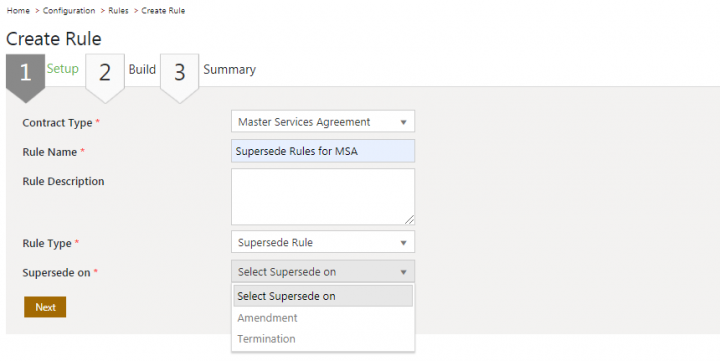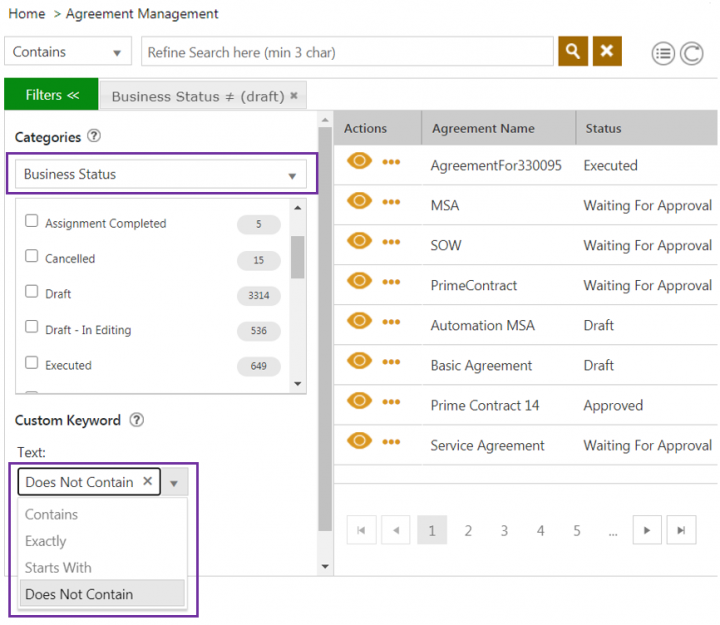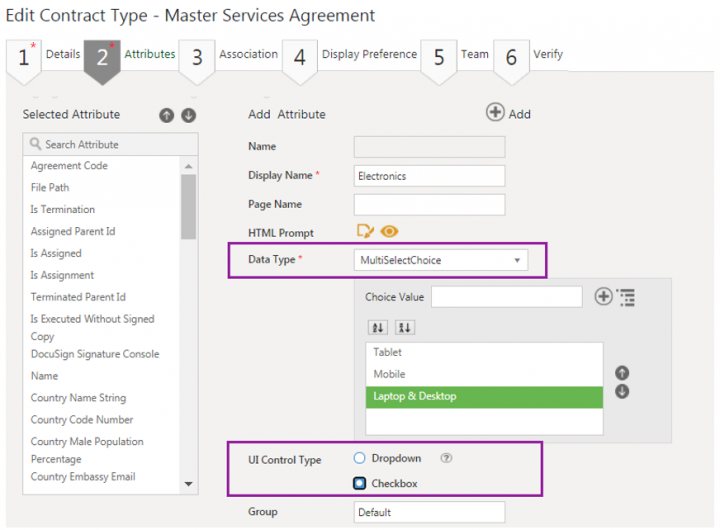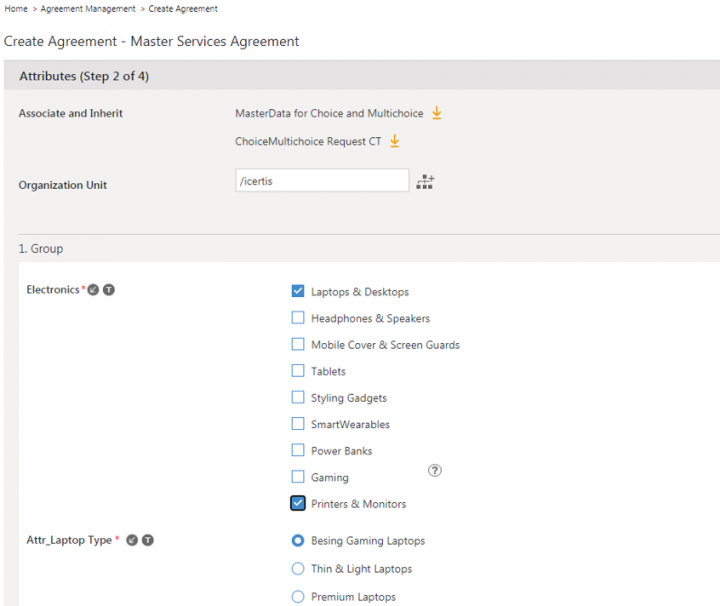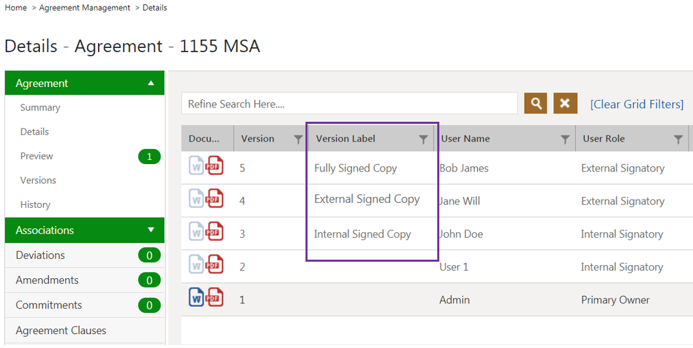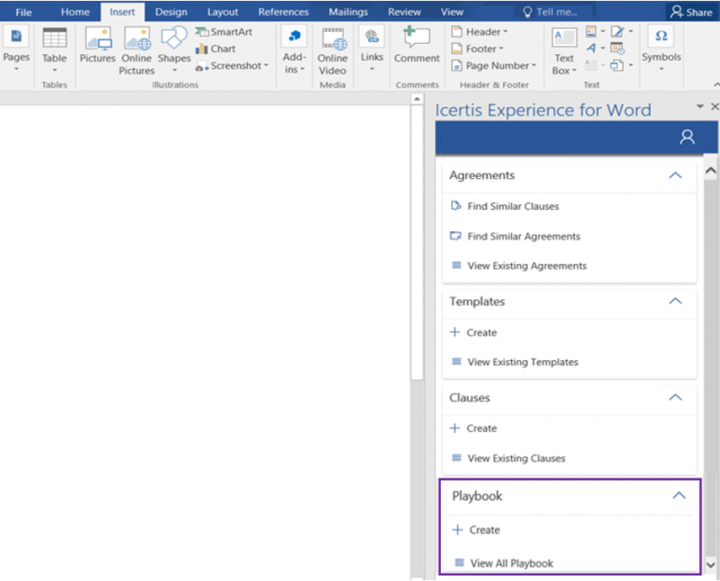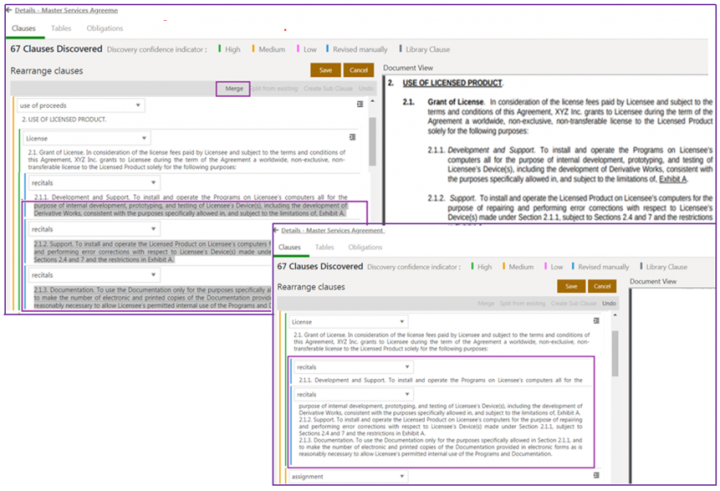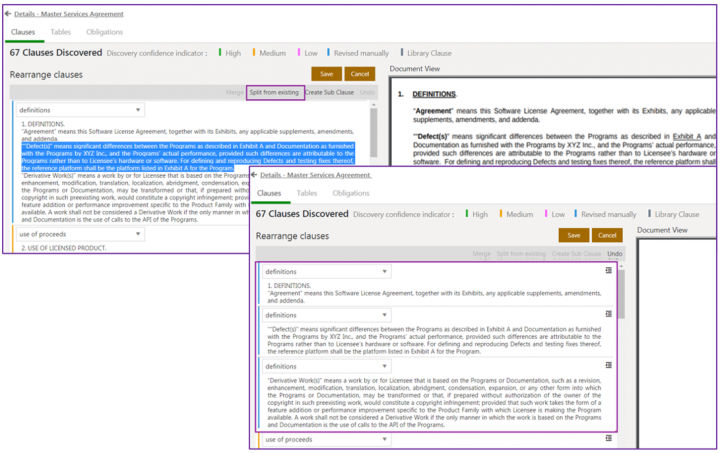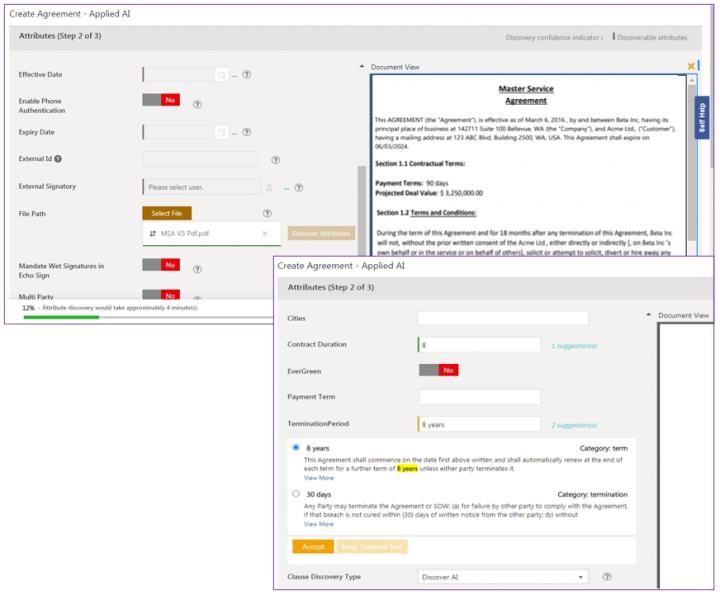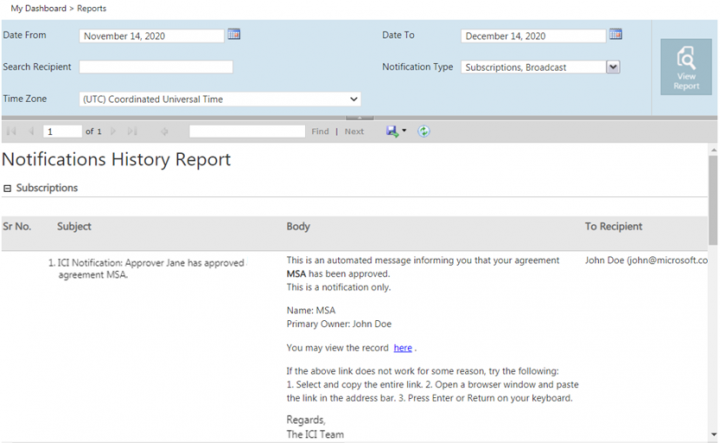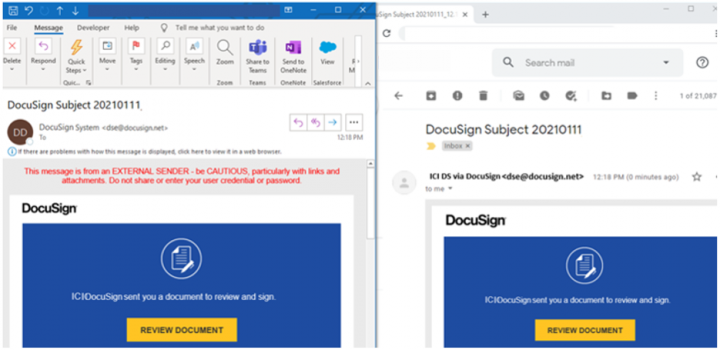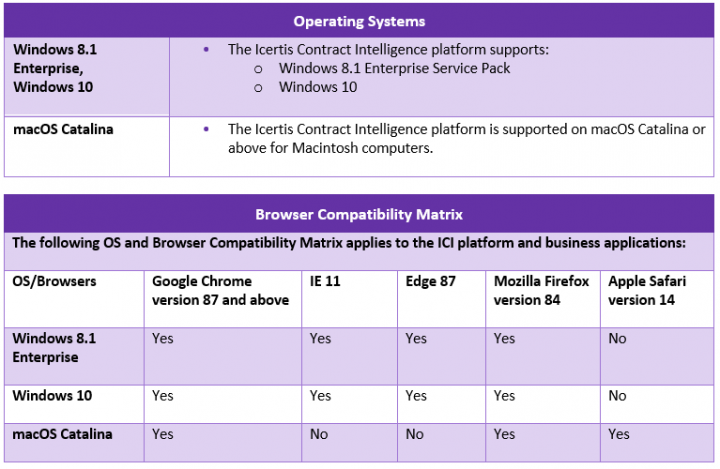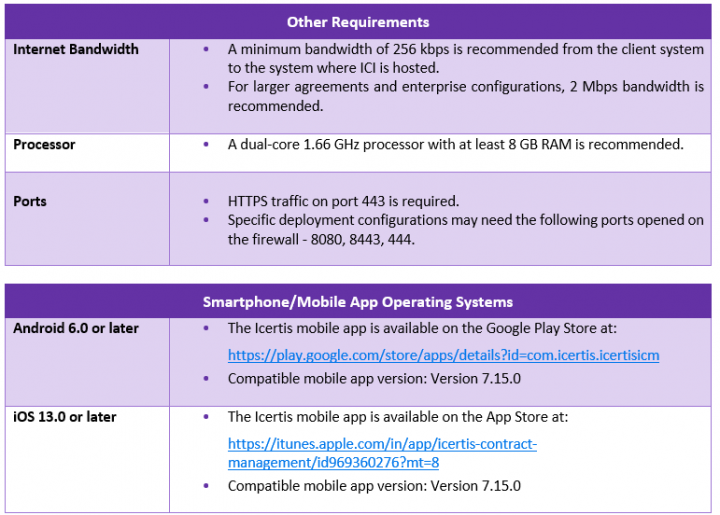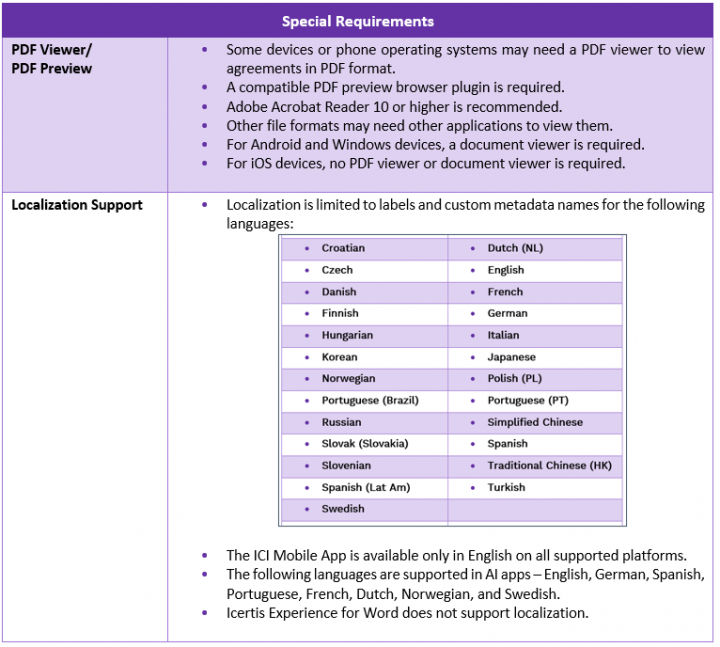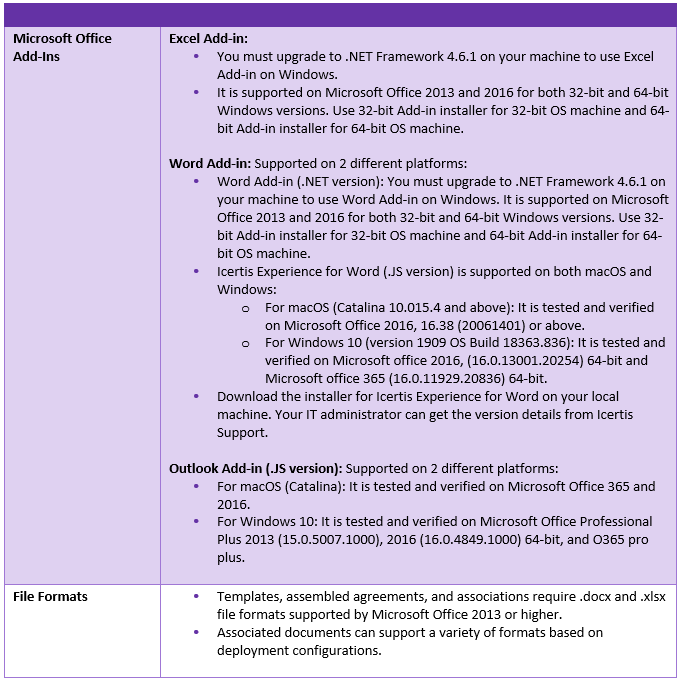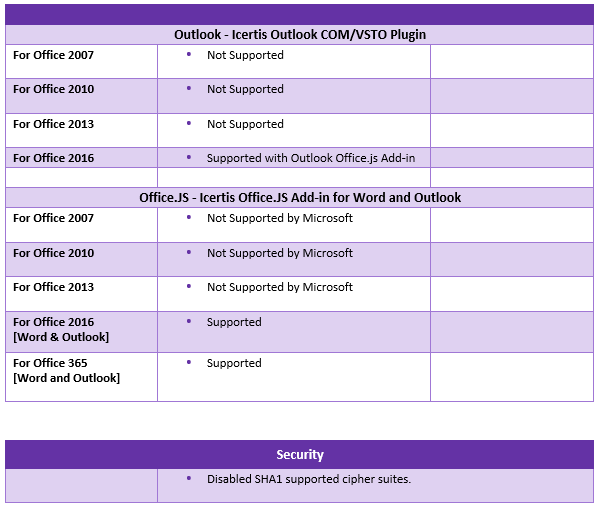Contents
- 1 ICI Release Notes - Release 7.15
- 1.1 List of Enhancements 7.15
- 1.2 ICI Application Enhancement Details
- 1.3 Mobile App Enhancement Details
- 1.4 ICI API Enhancement Details
- 1.5 ICI Add-ins Enhancement Details
- 1.6 AI Applications Enhancement Details
- 1.7 Reports Enhancement Details
- 1.8 Integration Details
- 1.9 Partner Enablement
- 1.10 Technical Requirements for Release 7.15
- 1.11 Known Issues
ICI Release Notes - Release 7.15
List of Enhancements 7.15
The 7.15 Release introduces significant enhancements to the Icertis Contract Intelligence (ICI) platform. It strives to enhance the user experience, intelligence, analytics, intuitiveness, and usability by continually improving the user interface and functionalities.
The key enhancements of this release include:
- Enhancements to the ICI Application
- User Experience
- To ensure that the agreement document is generated with the correct clauses and metadata, we now can preview an agreement from the pre-draft to the Approved stage, enabling a comprehensive review before publishing the contract.
- Improved usability for the global user base and their individual user interface (UI) language preferences via expanded localization coverage which now includes support for localized “Reason Codes”.
- Friction-free collaboration enabled via the Collaboration Portal’s external UI which now enables external users to search contract requests, agreements, associations, and masterdata records.
- Improved document review process where the display order for clauses in the ICI web and Icertis Experience for Word match the order in which the clauses are configured in the respective template and generated agreement.
- Improved usability whereby the attribute multi-selection interface, when creating an agreement, can be configured as either radio buttons or checkboxes to tailor the agreement creation experience per the contract type.
- Amendments to an agreement are now viewable in the “Grid” view in addition to the current “Tile” view. This provides more information and enables standard grid view functionalities such as search, filter, and export.
- Improved usability where the sequence of values displayed in a masterdata lookup drop-down can now be configured to have the most frequently accessed values available at the top of the list.
- User Experience
- Workflow Enhancements
- Improved usability including the ability to create instances of associations as part of the agreement creation wizard itself.
- To continue bringing Extension Attributes capabilities at par with regular attributes, these are now quickly viewable for easy reference in the agreement entity’s “Agreement Clauses” tab.
- Agreements can be Approved or Rejected from within an agreement notification email itself making it faster to take actions on an agreement and reducing turnaround time for approval cycles.
- Expanded contract request experience now includes the ability to request Contract Terminations.
- Bulk actions support is now extended to Terminating agreements in bulk to support situations that require it, such as regulatory changes, or business partner insolvency.
- To save time when re-instantiating a terminated agreement, due to reasons such as reviving a business relationship, you can now do so by simply adding amendments to the terminated agreement rather than by having to create a new agreement from scratch.
- Simplified administration of the first-run default user preference which can now be pre-set or updated for users based on their location or department.
- Simplified signature status labels such as “External”, “Internal,” and “Fully Signed” are now shown in agreement versions.
- Enhanced flexibility when executing a large volume of contracts by not requiring the immediate upload of documents to change the status to “Executed” for manual signatures. Instead, the agreement status will change from “Waiting For Signature” to “Executed – Pending Signed Document”.
- Enabling sharing of Associated Documents as well via the email notifications that are triggered for an agreement.
- For organizational changes or employee turnover, we now provide a data management interface that enables replacing users with multiple users on supported agreement entities.
- Support for granularly defining which agreement attributes for a given contract type should be cascaded to the agreement’s amendment via the “Is Inherit On Amendments” flag at the agreement contract type and template variable levels.
- In addition to the currently available functionality of all attributes to be superseded capability, we now offer the ability to selectively supersede an attribute through rules.
- Conditional attributes’ comparison operators now support multiple complex conditions to dynamically display attributes based on a range of business scenarios.
- Simplifying agreement workflow navigation by enabling the option to show a “No Team Available” message during workflows when a team is not needed.
- Expanded support for special characters in the Attribute display name for contract requests, agreements, associations, and masterdata.
- Download amendments with the corresponding parent and child associations in a zip package with corresponding sub-folders.
- Larger file size support when uploading (4GB) and downloading (6GB) files for masterdata and associations.
- Boost smart filter creation using string operators such as “Contains”, “Starts With”, or “Does Not Contain” for the “Business Status” search facet.
- Expanded support for automating the bulk upload of clauses and templates reducing the dependency on manual approvals and delays in onboarding clauses and templates.
- Enhanced configurable labels for peer associations that define the contractual relationship (such as, “Related To”, “Linked To”, “Addendum Of”, “Addendum To”, “Parent To”, “Child To”, and so on.).
- Mobile App Updates
- Enhancing the “Refresh” functionality for “Tasks” and “Commitment” tabs to continually show the latest changes in the status for mobile app users.
- Enhancements to ICI API 2.0
- Providing support for the script and integrated attributes as cascaded attributes for lookup fields when configured at the contract type level. This is applicable for retrieval, creation, and update of the instances of contract requests, agreements, associations, and amendments.
- Adding the identifier “TrackingId” which can be passed by subsequent API calls for logging and troubleshooting errors.
- Adding support for troubleshooting API issues with failure notifications.
- Enhancements to ICI Add-ins
- Icertis Experience for Word
- Improving the filtering and searching capability which now supports searching text inside clauses or templates to allow more powerful deep searches especially when searching across large libraries.
- Improved labeling of internal, external, and fully signed copies of agreements for easy identification of an agreement version.
- Defining and updating clause groups as per business requirements for easy categorization and management.
- Icertis Experience for Word
- Enhancements to Artificial Intelligence Applications
- Multiple enhancements to the AI-powered legal playbook capabilities:
- Improved usability by enabling larger window views of the “Details” page, including deviations.
- All the playbook positions for a contract type now have the option to search and filter.
- Administrators can create a new playbook record or update an existing one from within Icertis Experience for Word itself.
- Improving the clause delineation logic so that users can rearrange the AI-identified clause boundaries. You can now merge or split discovered clauses or selected text in a clause and also create sub-clauses within the discovered clause.
- Extending the clause hierarchy discovery feature to support text PDFs in addition to .docx documents.
- Improving library clause recommendations for discovered clauses based on learnings from user’s actions in previous discoveries.
- Providing support for additional languages including “French”, “Dutch”, “Norwegian” and “Swedish” in AI apps.
- Enabling users to flexibly leverage AI on-demand by manually triggering attribute discovery on an agreement from the “Attributes” page to accelerate workflows. The discovered values will be auto-filled in empty attributes, instead of redundant manual entry.
- Enhancing and optimizing the performance of Machine Learning services to simplify deployment and run the workload on-demand while significantly reducing infrastructure management needs.
- Multiple enhancements to the AI-powered legal playbook capabilities:
- Enhancements to Reports
- Introducing the “Tagged Attributes Report” enabling Administrators to understand the complete profile of an attribute and its utilization across clauses and templates. This will help the Legal/Admin users to assess the impact of configuration changes to the clauses and templates.
- Introducing the “Notifications History Report” for an entity, enabling users to track what notifications were sent to which recipient and when. This provides better visibility and compliance conformity for the users.
- Providing the ability to filter the “Agreement Deviation Report” and “Agreements Pending Execution Report” by “Agreement Status”.
- Enhancing the “Clause Summary Report” to display information on Extended Clause Attributes as well.
- Adding an “Organization Unit” filter in the “Cycle Time Report” to enable deeper analysis.
- Adding a new column in PowerBI for “Agreement Code” which navigates the user to the agreement in ICI.
- Multiple localization enhancements within reports.
- Improving the Icertis Experience
- Signature Workflow
- Improving the electronic signature process when using DocuSign to provide a unified, flexible signature workflow. This hybrid (manual and/or electronic) signature process enables users to add and modify signatories, preview the DocuSign console, and tag signatories in the console. Support has also been provided for Advanced Electronic Signature (AES) and Qualified Electronic Signature (QES).
- Enabling the ICI platform to support more than one E-signature vendor at the same time, to execute agreements and amendments, thus improving flexibility for users.
- Supporting parallel signatures in DocuSign to reduce the overall turnaround time for the complete signature process.
- Icertis Experience for Salesforce
- Providing the ability to send success and failure alerts for improved monitoring of messages.
- Triggering document assembly for automatic data sync and displaying completion notification.
- Supporting OAuth in Salesforce adapter for a more secure authentication and authorization process.
- Icertis Experience for MS CRM
- Providing server-to-server OAuth support, so that the adapter and the task service will use “client Id” and “secret key” from AKV, invoking the MS CRM APIs.
- Signature Workflow
- Additions to Icertis Software Development Kit for Partner Enablement
-
- With this release, the following SDK documents have been updated – ICI Coding Guidelines, ICI Customization and Use Cases, Working with ICI Tasks, Working with ICI Hooks, and Self-Serve Tools.
- With this release, the following SDK documents have been updated – ICI Coding Guidelines, ICI Customization and Use Cases, Working with ICI Tasks, Working with ICI Hooks, and Self-Serve Tools.
-
These release notes provide an overview of the enhancements to ICI, the mobile app, the ICI experience for integrations, and so on.
ICI Application Enhancement Details
514613 – Introducing the ability to preview agreements before publishing
Previously, contract owners had to create the first version of an agreement to get a comprehensive view of the agreement.
With this release, a preview functionality is being introduced, so that the primary owner or contract creator can review whether the selected template is appropriate, the rule-based clauses have been correctly added to the agreement, among other factors, and make changes to the agreement before the version is created. The preview document would also include tagged associated documents, coming through inline or inheritance associations.
A preview section is available on the “Verify” stage of agreement/amendment creation, before publishing or updating the document. The PDF preview is for indicative purposes only and is not an agreement version. The preview is available till the Approved state of the agreement/amendment.
Note: This functionality is configurable. It is not available by default and can be enabled or disabled for chosen contract types.
575640 – Creating associations on the create or edit wizard of agreement
Previously in ICI, contract authors had to create associations for agreements after the agreement was already created. However, in practical terms, associations such as annexures, supporting documents, SLAs, product specifications, rate tables, and so on, are all an inherent part of the agreement information that is critical to the business, and some associations are required to be created along with the agreement.
Hence, the ability to create association instances as part of agreement creation or update wizard is being introduced in this release. A separate page is displayed, when creating or updating the agreement or amendment for the user to create, view, or delete inline associations. The user also has an option to select the columns and their order in the association grid.

This new page also supports page navigation. Support is also provided to copy attribute rules, association events, and agreement assembly, in case associations are tagged in the agreement template.
Adapting existing products to new markets through translation and localization is the key to global growth. The localized versions of the product improve the overall user experience and help to better connect with new and potential global customers.
ICI now extends its localization support to reason code values. Administrators can enter the translated values in the local language, for each reason code, using the “Translations Editor” tool.
Users can see localized reason codes as per their preferred language settings.
The reason code will be displayed in English if there are no local values available in the ICI system for that specific reason code.
614944 – Initiating termination for parent agreement from the contract request
To terminate an agreement in ICI, users create and execute a termination agreement on the main agreement instance. This capability is now extended to initiate the termination from contract requests as well.
Users can now enable the termination process at the contract type level using the seeded attribute "Request for Termination", select the parent contract request, and create the termination contract on a contract request. The termination instance for the contract request will have all the common attribute values inherited if the inheritance is enabled.
The termination record will be displayed as a peer association under the “Associations” tab for the contract request. The access privilege for the contract request termination process is controlled through role action mapping.
506398 – Enabling search for external users with login privileges
The Collaboration Portal allows external users with login privileges to access the platform and perform assigned tasks within ICI itself.
In our continuous effort to improve usability, a search option has been introduced on contract requests, agreements, associations, and masterdata index pages, so that external users can easily search records. The attributes displayed as columns of the search grid are included as facets in the filter options to perform a more refined search.
514605 – Supporting extended clause attributes in agreements
In ICI, users can capture additional details for a clause in extension attributes. With this release, users can view these clause extension attributes on the agreement entity for easy reference while working with agreements.
Users can now:
- Select and save extension attributes to display in the grid view, via the default search column functionality.
- View additional clause attributes on the “Agreement Clauses” and “Clause Approver” tabs.
- View the hyperlink “Show Clause Information”, which displays all clause extension attributes along with clause attributes, in the same window.
514615 – Streamlining the approval process over emails
The approval process has now been streamlined by allowing approvers to directly approve or reject an agreement from within the email itself, through a hyperlink to the webpage, instead of logging in to the system to do so. External users, who do not have access to ICI can now review or approve documents from the notification email, instead of sending offline copies to do so and then uploading them to ICI. This reduces the overall turnaround time and increases productivity.
Internal users are authenticated through the SSO/IDP before opening the page where the actions are to be taken. External users are authenticated by sending them a code in the email, which has limited validity.
With this release:
- Administrators can add tags for an Approve/Reject link in the notification template.
- Approvers/reviewers can download the agreement, modify it and upload it back to ICI based on the access provided.
- Approvers can approve/reject the agreement or amendment from the email, only if the task approval or review is assigned to them. Based on the access, the user can approve or reject the agreement by entering notes or reasons for rejection, respectively.
617385 – Ability to define additional clause group under clause entity
Previously, ICI supported 3 clause groups – “Termination”, “Legal” and “None”.
With this release, this capability has been further enhanced so that the configurator can configure various clause group names in ICI. These clause groups can be categorized or grouped as per business requirements for better identification and negotiation during the contract workflow.
Administrators can now:
- Define and update clause groups.
- Edit, delete, activate or deactivate clause group entities.
- View additionally added clause group values in the clause entity when creating or editing a clause.
- Search agreement records or clauses on the index page on clause group attributes with added values.
514643 – Ordering of clauses as tagged in an agreement
To improve the user experience, clauses are now displayed in the same order in the agreement document as they are tagged inside the agreement, on the “Agreement Clauses” tab, in ICI Web and Icertis Experience for Word.
514621 – Reviving terminated agreements
Users may terminate an agreement with the other party for various business reasons. To improve usability, ICI now provides the capability to add and execute amendments on a terminated agreement. This considerably saves time for users who may want to re-instantiate their existing relationship with the other party, as they no longer need to create an entirely new agreement and go through several workflows such as clause deviations clearance, template process, and so on.
Adding and executing an amendment on a terminated agreement will move the agreement back to the “Executed” or “Expired” state, based on its expiry date, thus reviving the terminated agreement. The system sets an identifier attribute "Is Termination Revived" for such revived base agreements, and they can be used in search filters, notification rules while configuring saved searches, and so on.
Note: By default, only primary owners and contract managers can add an amendment to the terminated agreement. The access privileges are controlled through role action mapping.
514625 – Terminating agreements in bulk
Users may need to terminate agreements in bulk in many business scenarios such as regulatory changes, changes in product offerings, and so on. Users can now initiate the termination of agreements in bulk, thereby saving the time to terminate agreements one by one and reducing manual errors.
Bulk termination is carried out using ICI’s existing “Bulk Actions” process. The termination related attributes will be pre-selected, and the Workbook for the bulk action batch will be generated with the executed agreement records from the saved search, as per the selected contract type and termination contract type.
Users can now:
- Initiate the termination workflow using “Bulk Actions”, by creating and executing a new batch.
- Generate and view a status report for agreements terminated in bulk.
- Create termination agreements for “Draft”, “Published” or “Send for Approval” states, as per the batch Workbook configuration for bulk actions.
Note: All prerequisite configurations applicable for the termination workflow should also be set for the bulk termination process.
555898 – Defining display sequence on lookup attributes at the contract type level
Previously in ICI, users could not define the display order for lookup attribute values in a drop-down menu on the UI that references masterdata. Users had to scroll through all the populated values to find the desired values during agreement creation.
Configurators can now define and maintain the display sequence for selected masterdata records, starting from 1 to n, at the masterdata contract type level, using a seeded display sequence attribute. The values will thus be displayed at the top for easier and faster selection in lookup attributes.
This display sequence setting is supported on the create, edit, and lookup search pages of contract requests, agreements, amendments, associated documents, extended clause entities, and template variables. The display will follow the default alphabetical order if the display sequence is not configured in masterdata.
558605 – Viewing amendments in grid view on the agreement details page
Previously in ICI, users could only view the agreement’s amendments in a “Tile” view, when opened from the left navigation pane on the agreement “Details” page.
Users can now view amendments in the “Grid” view, and toggle between grid or tile view. The grid view is the default for amendments and supports all existing grid functionalities, such as standard search, filter, column selection, pagination, export to CSV/Excel, and so on.
561410 – Enhancing the multi-select drop-down
The multi-select choice drop-down has been enhanced for better usability, data input, and post-selection data review of contract requests, agreements, amendments, and masterdata entities.
Users can now:
- View eight options in a drop-down list (instead of six), without scrolling.
- View larger values with adjusted drop-down width, according to its size, in the post-selection view.
- View all selected values at the top of the drop-down.
- Deselect the selected values, individually or all with a single click, without opening the drop-down.
620411 – Defining IN operator when applying lookup filters
In ICI, the configurator can filter the lookup masterdata table with “Must” and “Must Not” conditions, to achieve necessary business scenarios, while configuring a lookup attribute on contract types.
With this release, ICI provides the ability to configure a lookup attribute using the “IN” filter operator, and display selected multiple values, by referencing multiple values on another lookup masterdata attribute.
Configurators can now:
- Use the "IN” operator in the lookup filter attribute on agreement contract types.
- View the applied filter on the “Attributes” page on the UI for the selected attribute.
Standard ICI users can view only selective values in the lookup attribute as per the referenced value in another attribute.
573339 – Managing user preferences as part of profile management
Users can set preferences for their ICI Web UI account such as language, color theme, time zone, and so on.
Administrators now have the capability to set preferences as default, for users, according to their locations or the offices they work in. This reduces the end user’s effort in setting up their ICI account with the required parameters after the first login and presents the system with appropriate and specific pre-configured settings.
Administrators can:
- Set and manage preferences for a single user through a single user update, and for multiple users through the bulk process.
- View preference settings modification details in the “History” tab for audit.
- Search users based on parameters related to preference settings.
Users can:
- Access the ICI system with appropriate details as default, after the first login.
- Override the default preference settings as per individual preferences.
604775 – Moving agreement to executed state without uploading the document
Previously in ICI, users could not move agreements and amendments from “Waiting For Signature” to “Executed” state, without uploading the supporting document, in case of manually signed agreements.
With this release, users can now skip uploading the document, to move agreements from “Waiting For External Signature” or “Waiting For Internal Signature” to the “Executed – (Pending Signed Document)” state.
Users can then search or create a saved search for such agreements and upload the required documents later using the “Upload Fully Signed Copy” action. Notifications can be configured to inform users about skipped document uploads so that they can cover for delays occurring due to the scan and upload process while executing a large volume of documents.
This functionality is available for agreements, amendments, and orphan amendments.
614860 – Attaching associated documents to agreement notifications
ICI users can share the main agreement document as part of various email notifications that get triggered for the agreement.
In addition to the main agreement document, users can now send associated documents as part of various email notifications that get triggered for the agreement from time to time. Access to these documents can be controlled based on the type of document – internal, external, or restricted. For example, some documents may only be shared with internal users, some may be shared with internal and external users, whereas some may not be shared with anyone.
With this release:
- Administrators can tag the associated document contract type in the email notification template for agreements, assignment agreements, termination agreements, and amendments.
- Users can define:
- The type of notification as internal or external.
- The type of associated document instance as internal, external, or restricted.
- Based on the type of notification and type of tagged associated documents, attachments are added to the email notification.
586492 – Defining different relationship types while associating peer instance
ICI allows users to define the linkage type as a parent, child, or peer while associating peer entities with each other.
With this release, users can define configurable labels for peer associations between existing contracts by configuring the “Linkage Type” masterdata. The configurable labels define various business relationships in the context of contracts. For example, “Related To”, “Linked To”, “Addendum Of”, “Addendum To”, “Parent To”, “Child To”, and so on. The labels can be activated or deactivated as per business requirements.
The configurable labels support the existing two-way linkage and self-linkage types. The amendments on executed agreements will be associated as peer, with default peer linkage type label, defined in the default peer mapping for the amendments.
Users can select configurable peer linkage type labels in the “Linkage Type” drop-down list and view them on various ICI functionalities such as:
- Agreement creation workflows for peer entities, assignment, and initiate termination flow.
- Associate and Inheritance icons.
- Bulk actions.
- Agreement creation through business APIs.
- Broadcast – “Attachments” tab and captured notes.
Note: Multiple configurable labels are not supported for parent and child linkage types, as there is specific business logic built with them in the ICI system.
619558 – Downloading amendments using download all functionality
ICI users can download an agreement and all its associations in a zip file using the “Download All” action available on agreements.
With this release, users can download amendments of an agreement with corresponding parent-child associations in the downloaded zip package. This is supported on the selective download option too.
For ease of access, each selected amendment will be downloaded with its selected associations in separate folders. The folders are named “Amendment_1”, “Amendment_2”, and so on (from oldest to latest), instead of actual amendment names. This helps to overcome the Windows limitation of supporting 260 characters in the file path and gives flexibility to users while creating association names.
615291 – Configuring attributes inheritance for amendments at the contract type level
ICI already provided the capability to exclude specific agreement attributes from being copied to amendments through technical configuration, which applies to all agreement contract types by default.
Configurators now have the flexibility to decide which attributes of an agreement can be copied to amendments at the contract type level, as per business requirements. They can enable or disable the attribute’s inheritance for amendments, using the “Is Inherit On Amendments” flag, at the agreement contract type and template variable levels.
Users can then copy these defined attribute values from base agreement to amendment during amendment creation.
Note:
- The technical configuration settings for excluding parent agreement attributes from its amendments will always take preference over the settings at agreement contract type and template levels.
- The existing validations or dependencies for an attribute’s properties set for the agreement will not be inherited to amendments.
614877 – Replacing a user with multiple users
In ICI, administrators can replace user(s) with all associated records using the “Replace User” functionality. In practice, administrators may need to replace a user with more than one user. For example, if a user leaves the organization, the administrator may want to replace that user by dividing agreements associated with that user, in subsets, among multiple users. This would help the organization to balance the workload within its employees.
Administrators can now:
- Replace the user with one or more users, by selecting the entity and all/selective instances of that entity, and create a saved search for records to replace users.
- Validate the replaced user role against the assigned role.
- Get a notification on adding or completing a task.
This capability is available across ICI for contract requests, agreements, associations, masterdata, template and clause teams, user groups, and rules. A separate data management UI is provided to carry out these user management actions.
615293 – Showing or hiding the No Team Available message
In ICI, users may encounter specific workflow configurations, such as the self-approval process, that do not require users added to the team. The “No Team Available” message, displayed in such cases, adds to the number of non-value clicks for users to continue.
ICI now can suppress this message through technical configuration, thereby minimizing the number of unnecessary clicks.
Administrators can:
- Selectively enable or disable the “No Team Available” message window, at the entity contract type level, appearing at various states.
- Disable the “No Team Available” message window altogether, at the instance level, for all entities. The instance level settings will override the entity level settings.
Note: This capability is available across ICI for all entities, events, integrations and add-ins in ICI.
614963 – Superseding agreement values as per amendment using rules
In ICI, users could supersede all attributes of a parent agreement configured as ‘supersedable’ with values from its amendment, either manually using the “Supersede” action or automatically through the auto-supersede task. Users can now selectively supersede individual entities based on business conditions.
The administrator can control the supersede functionality for agreements by:
- Enabling Auto Supersede option at the contract type level.
- Configuring the “Supersede Rule” with “Is Supersede by Amendments” or “Is Supersede by Termination” options.
- Selecting attributes in rule actions based on the selected Supersede On option.
Users can view the attribute’s supersede value on the agreement and the captured history as per the rule execution. When no rule is configured, the supersede functionality will work as per existing ICI behavior.
618345 – Defining complex conditional logic for attributes visibility
Previously, users could configure a conditional attribute for a contract type with simple conditions using a single “equal to” operator.
With this release, configurators can now set multiple, complex conditions to display ICI Web UI attributes dynamically, based on business scenarios. They can define conditions for attributes of all entities, except for template variables. For example, the configurator can set conditions to display an attribute based on the selection of specific values in any of the attributes mentioned in the condition. The user experience would be similar to the existing ICI conditional attribute functionality.
Users can now:
- Apply multiple and complex conditions to display an attribute by enhancing the enable expression (Visibility Expression) for contract requests, agreements, associations, and masterdata contract types.
- Support conditional expressions for extension attributes.
- Define conditions with different operators based on the selected attribute data type.
- View the conditional attribute value according to the value entered in the attribute on which a condition is set.
616901 – Applying facets to business status search filter
Business statuses are prominently used by all customers as they reflect the actual status in business terms as compared to the system workflow status. Previously, the ICI search functionality supported filters on “Business Status” for users to refine results. However, manually selecting filters often becomes a tedious task in case there are several business statuses.
For ease of use and a better user experience, faceted filters using string operators, such as “Contains”, “Exactly”, “Starts With” and “Does Not Contain” have been added to the “Business Status” filters.
694211 – Improving handling of exceptions for string combinations
Previously, some combinations of special and alphanumeric characters used as input values resulted in generic exceptions.
ICI's parsing logic is now improved for handling string combinations with special and alphanumeric characters so that no errors are generated. This applies to all entities across ICI, where a combination of special characters, alphabets, and numbers can be used.
732929 – Uploading clauses and templates in bulk
New customers or new groups onboarding to ICI mostly have their templates and clauses already created in a separate file. Previously, manual efforts were needed to onboard hundreds to thousands of templates and clauses.
With this release, the bulk import functionality using the “Legacy Upload” tool has been automated, which will reduce any human dependency, manual approvals, and delays for onboarding templates and clauses using the current capabilities. ICI administrators can now import templates and upload clauses to ICI in bulk.
Along with the tool, an XML specification document is also released which can be used for creating tags in the input document files of clauses and templates.
655507 – Uploading and downloading large files with the file path attribute
ICI now provides support for larger files. This applies to masterdata and association entities.
Users can now:
- Upload files up to 4GB under the file selection attribute.
- Upload files with all supported file extensions allowed in the file selection attribute.
- Download All/Download Package up to 6 GB.
ICI supports virus scanning of large files if the virus scan feature is enabled.
Note: This is not applicable for contract requests, agreements, or associations with large files in the DocuSign/Adobe Sign association selection pop-up, document assembly, bulk actions, legacy upload, integrations (Salesforce, Workday, etc.), and APIs. The Upload/Download of the files would be supported for Azure and Windows Storage.
618994 – Supporting special characters in agreement templates and support to skip empty columns while a saved search/association is tagged in a template
Previously in ICI, attribute names did not support special characters, apart from _ (underscore), & (ampersand), and space.
Now, support is provided for special characters in the attribute display name. The characters *(asterisk), - (dash), : (colon), ( (parenthesis open), ) (parenthesis closed), ’ (apostrophe), , (comma), and . (period) can be used in the display name of attributes for contract requests, agreements, associations, and masterdata contract types. The same attribute display name, as provided by the configurator, will now be displayed including special characters.
In scenarios where the association or saved search is tagged as a table in the agreement, and a particular column of the table does not have any data, we have introduced a functionality to skip such empty columns.
During template creation from Icertis Experience for Word, the configurator can add a “SkipEmptyColumns” property while tagging an association or a saved search as a table. This property needs to be added manually in the “Content Control Properties”, at any position after the contract type GUID, separated by a '|' (pipe separator). This enables empty columns to be skipped in document assembly, thereby eliminating unnecessary empty columns in the agreement version. The order of the columns in the table is determined by the attributes in the display preference of the associated document contract type.
Amendments to an agreement are now available in the grid view in addition to the current tile view. This provides more information and enables standard grid view functionalities such as search, filter, and export.
573336 – Displaying drop-downs as radio buttons or checkbox list for user selection
With this release, ICI provides new controls for multi-select and single-select choice attributes.
Users can configure an alternate UI control for drop-downs with a limited number of values for choice attributes at contract type, global attribute, and template variable levels. This improves the user experience as the number of clicks and scrolls required to view options in a drop-down is considerably reduced and provides better readability in terms of post-selection data review.
Users can select:
- The radio button for single-select choice attributes.
- The checkbox list for multi-select choice attributes.
The configuration applies across ICI for the creation and editing of agreement, amendment, associated document, masterdata, and contract request entities.
593421 – Labeling agreement document versions as per signature copy
While agreements go through various signature states till executed, users can now navigate to the “Versions” tab and easily identify which version of the agreement is internally signed, externally signed, or fully signed.
872309 – Providing flexibility for assembling associations tagged as clauses
In ICI, on publishing and updating actions, all clauses are evaluated, assembled and the changes are reflected in the agreement document. However, if associations are tagged in clauses, on “Assemble Contract” and “Send For Approval” actions, clauses do not get assembled and associations do not get populated in the agreement document.
As part of our continuous effort to provide flexibility to ICI users and improve the user experience, a key “Core.Agreement.EnableDynamicClauseAssemblyPostCreate” has been introduced.
- If the key is enabled, when an associated document is uploaded, the entire document will be automatically assembled (Clause, Attribute, Associations, Saved Search) on the “Assemble Contract” and “Send For Approval” actions.
- If the key is not enabled, the ICI document will be assembled on “Publish” and “Edit Agreement” actions. Only associations will be assembled on the “Assemble Contract” and “Send For Approval” actions.
Note: By default, the key is set to false.
Mobile App Enhancement Details
773907 – Refreshing tasks and commitments
Icertis mobile app users perform actions such as approve, reject, and request review on contract requests and agreements. However, the status of the requests or agreements list did not automatically refresh on the mobile app.
Enhancements have now been made to the “Refresh” functionality for “Tasks” and “Commitment” tabs to refresh on these actions and improve usability automatically.
850259 – Updating logo and ICM to new guidelines
As part of our new branding, “ICM” has been updated to “ICI”, and the new logo has also been added to the mobile app.
773923 – Changing compatibility in Android 11
Android 11 compatibility changes have been made with this release by setting the target SDK version to 30 and deprecated methods have been updated.
773917 – Deprecating the UI WebView component for iOS
With this release, the UI WebView component for iOS has been deprecated.
ICI API Enhancement Details
704069 – Enhancing ICI API 2.0 implementation
With this release, support has been added for the script and integrated attributes. They are available as cascaded attributes for lookup fields when configured at the contract type level.
This is applicable for visualizing, retrieval, creation, and updating of instances of the following entities:
- Contract Requests
- Agreements
- Associations
- Amendments
New visualize endpoints have also been added for the above entities to get information about their attribute and template configuration.
756815 – Downloading associated document API
ICI already supports downloading agreements. As part of our efforts to continually improve ICI, new API endpoints have been added in this release to download associated documents of agreements and contract requests.
731961 – Provisioning success or failure message for workflow operations
A new service bus topic has been created to publish messages about workflow operations. The messages will notify if any failures are encountered during workflow actions.
As workflow APIs are asynchronous, customers using Actions API and API 2.0 get a return success code, only on the initiation of the workflow. This functionality has been improved so that messages on the service bus are received even for failure notifications.
Users will now get a definite response with required details of the error and cause on the service bus. Based on the topic notification, integration developers can take follow-up actions based on success and failure.
660859 – Supporting TrackingId in APIs
To work with ICI entities, at times, multiple API calls are needed to complete an operation.
For example, to create an agreement, the following APIs are called in a sequence – “GetInstance”, “SaveExternalUser”, “GetTemplate”, “CreateandPublish”, “ResumeWorkFlow”, “Prepare”, “Create”, “Get”, “Send For Approval”, and “Send for Signature”.
In such cases, due to heavy load, it becomes challenging for administrators to troubleshoot the operation that caused the failure of the agreement creation. An identifier has been added to resolve this issue which subsequent APIs can pass for correlating from a logging perspective.
The following API changes have been made to ensure that the existing implementation and code remains intact:
- Provided support for a “TrackingId” header in every logging request.
- Users will receive the “TrackingId” provided in the request header as part of response headers. (If the user does not send a value, then a new unique identifier will be returned).
- The called API path with the query string will be logged in Kibana. In Kibana, developers must look for “CorrelationId” which maps the “TrackingId” used in the API.
Note: The implementation of the "TrackingId" is optional and the value must be GUID only.
This can be used for:
- Related API Calls
- Async operations
- Bulk operations
- Status check operations
ICI Add-ins Enhancement Details
668859 – Enhancing filtering and searching of clauses
ICI users may need to modify an agreement as per business requirements by adding a clause. The clauses are displayed by “Clause Group” in the clause library by default and then searched by the clause name.
Multiple filters can now be configured at the clause and template level to help users easily retrieve relevant data. This improves usability for customers having a large number of clauses and templates in their clause and template library.
Users can now:
- Filter and search clauses and templates by clause metadata in the clause and template library respectively.
- Filter and search clauses and templates by extended clause metadata in the clause and template library respectively.
- Perform free-text search on the clause and template content.
AI Applications Enhancement Details
727318 – Enhancing AI-powered playbook in Icertis Experience for Word
ICI provides the legal playbook in Icertis Experience for Word that uses artificial intelligence to identify exceptions in the contract document and allows users to review and take corrective actions on them, and assess the risk when negotiators accept these exceptions.
The legal playbook is now enhanced and provides more options to work with the playbook from Icertis Experience for Word.
With this release:
- Negotiators can easily review the playbook exceptions found in deviated agreement clauses on the “Agreement Clause” page.
- Negotiators now have an option to view playbook details in a separate resizable window as the details of the playbook position for a clause can be lengthy.
- As AI may not be able to find all the playbook positions for a type of a contract, an option has been added to view all playbook positions for a selected type of contract, with options to search and filter within, so that negotiators have a ready reference for all applicable playbook positions while reviewing the contract.
- Negotiators can view all the applicable playbook positions for a selected agreement clause.
- Negotiators can request approval for a playbook exception from the playbook “Details” page.
- Legal administrators can add a new playbook position for a type of contract or edit the existing playbook position from within Icertis Experience for Word itself.
575475 – Automating user feedback during clause review
ICI AI apps have been positioned to be intelligent assistants to help users in taking decisions when populating details for agreements. While AI discovery recommends values to users, it is expected that users would select the correct value at the time of review.
While reviewing a discovered clause, AI suggests a list of library clauses to be matched with the discovered clause. If a user selects one of them or selects a completely new clause from the library, the AI algorithm learns from such user actions. These learnings are incorporated in the next discoveries to improve the accuracy of clause recommendations.
539492 – Rearranging discovered clauses
Clauses found using DiscoverAI in an agreement document are displayed with clause categories in the “Clause Discovery” section on the Web UI. Sometimes, AI may identify the clause boundaries incorrectly. Users can now review and rearrange boundaries for such clauses on the “Clause Discovery” page.
In rearrangement mode, users can:
- Merge multiple discovered clauses into a single clause or split a large discovered clause into multiple clauses.
- Identify a section of the discovered clause as its sub-clause.
- Rearrange the clause hierarchy in case of misclassification by AI. Users can change clause hierarchy and identify a clause as a parent, child or peer of one or more clauses.
- Change the AI recommended category of a clause.
- Choose to view only the parent clauses.
770375 – Infusing attribute discovery in agreement creation workflow
Previously in ICI, the AI attribute discovery process on agreements with third party paper was triggered on create and post-create events such as publish. Typically, users might have already entered attribute values by the time they trigger/perform the create/publish action, thereby making the attributes discovery process redundant. Also, two different attribute pages had to be maintained, with personalization and validations not being available on the attribute discovery page.
With this release, users can manually trigger the attribute discovery on the “Attributes” page itself, while uploading a third party document, during the agreement creation process. Discovered values will then be auto-filled in empty attributes and users can view additional potential options for the discovered attributes.
Users can:
- View the progress of the attribute discovery.
- Identify AI discoverable attributes on the “Attributes” page of the agreement creation wizard.
- View the values recommended by AI for discoverable attributes.
- View the agreement document on the “Attributes” page itself, for quick validation of AI recommended values for discoverable attributes, as well as attribute values already tagged in the agreement document.
Note: When an attribute discovery is triggered from the “Attributes” page, the two-column attributes layout is converted to a single column layout, to accommodate the agreement document view.
727312 – Clause hierarchy discovery in text PDFs
In the previous release, clause hierarchy discovery was introduced in well-formatted .docx agreements.
With this release, the clause delineation functionality has been enhanced to support text PDF documents and Word documents that do not use any styles. This enhancement helps to get better clause delineation, eliminates a large number of incorrectly classified clauses, and allows users to review the parent clause and child clause individually.
Clause discovery processor is now trained to identify sections and sub-sections in Word and PDF documents up to 3 levels. Support for formatting-based clause delineation has also been extended to the Icertis Experience for Word, wherein the discovered clauses are displayed to the user in a hierarchical format.
727314 – A generalized framework to support additional languages in AI apps
In the previous release, support was provided for clause and obligation discovery for agreements in English, German, Spanish and Portuguese languages.
With this release, a language framework has been implemented for AI discovery which can support a large number of languages. Using this generalized framework, DiscoverAI, NegotiateAI, and DiscoverAI for legacy apps have been enhanced to support additional European languages – French, Dutch, Norwegian, and Swedish.
Along with the clause and obligation discovery support, AI models can now discover attributes too, in all the supported languages.
Reports Enhancement Details
514593 – Introducing the Tagged Attributes Report
With this release, a new “Tagged Attributes Report”, has been introduced which helps administrators understand the complete profile of an attribute and how it has been tagged across different clauses and templates. This provides them better visibility into attribute usage and saves them considerable time.
This report, available on the “Reports” tile, can be accessed based on the security groups’ configuration.
The report can be filtered using the “Select Attribute” and “Select Entity” parameters.
Based on the selected entity, the following columns are displayed – Clause/Template Code, Clause/Template Name, Contract Type, Clause/Template Version, Clause/Template Created By, Clause/Template Created On, Version Updated On, Attribute tagged as Template Variable, Attribute tagged as Clause Extended Attribute and Attribute Display Name.
769602 – Displaying clause extension attribute summary in the Clause Summary Report
Previously, the “Clause Summary Report” displayed “Clause Summary” and “Clause Version Summary” sections on the report index page.
In this release, the report is being enhanced to display “Clause Extension Summary” which displays details on extended clause attributes. If the clause extended entity is defined for an ICI instance, then this report will display the information of the clause extension attributes. The “Clause Extension Version Summary” will display the latest values of clause extension attributes.
514611 – Introducing the Notifications History Report
ICI administrators can set up subscriptions for different entities, for notifications to be sent to subscribed users at the occurrence of certain events. Notifications can also be sent using the broadcast functionality. The “Notifications History Report” provides visibility into which notifications were sent, when, and to whom, by displaying an audit history of notifications for that particular entity.
The default report is available for contract requests, agreements, and associated documents, and is accessible through the left navigation pane of the details page, for an instance of the aforementioned entities. This report displays a list of notifications sent for an entity, including details such as the event that triggered the notification, the message body, subject, the To, CC, BCC recipient names, and email addresses, along with other details such as the attachment filename or sent date and time.
742607 – Providing additional localization support in reports
With this release, localization support will be provided in the Core platform, Sourcing, Obligation Management, and Insights SSRS report, in the following areas:
- Contract type names, if the respective entity has locale resource key values in the database.
- Drop-down with Yes/No values.
- Graph and Time zone tooltips, if present in the report.
- Column headers.
- Any error or validation messages.
- Informative messages such as “No data available”.
583297 – Filtering additional reports by agreement status
Previously, the "Agreement Status" filter was available for the “Agreements Pending Approval Report”, “Expiring Agreements Report”, “Average Agreement TurnAroundTime Report” and “Expired Agreements Report”.
This filter is now also available for the "Agreement Deviation Report" and "Agreements Pending Execution Report". Users have the option to exclude terminated or archived agreements from this report, thus allowing them to derive the exact number and information as required.
746607 – Enhancing the Cycle Time Report
The “Cycle Time Report” displays the cycles for contract requests, agreements, agreements with contract requests, and the change of status for each entity from the date of creation to the date of execution, as well as the elapsed time. This enables users to get the turnaround time for tasks and take corrective actions wherever necessary.
With this release, an “Organization Unit” filter is being introduced in this report for users to derive the desired information.
737196 – Adding hyperlink in PowerBI for agreement code
With this release, the user creating a PowerBI report can hyperlink the "Agreement Code" using conditional formatting with the Web URL option, so that on clicking an agreement code, the user is navigated to the corresponding agreement in ICI.
Integration Details
605434 – Providing a unified flexible signature process
Signing agreements is often a combination of manual signatures and electronic signatures. ICI now provides a unified flexible signature workflow to its customers, thus improving the overall turnaround time and reducing the efforts of printing and scanning manually signed documents.
With this release, the ICI signature process has been enhanced as follows:
- The hybrid signature process has been introduced that allows the usage of manual and electronic signature modes in a single transaction.
Note: If the DocuSign console is enabled, then the user has the provision to tag the signatories after manual signatures. For other signature modes, ICI relies on the provisions facilitated by your signature provider.
- The DocuSign console has been enabled with ICI that allows users to:
- Add and modify the signatories.
- Change the signature sequence.
- Preview documents in the DocuSign console.
- Tag signatories in the DocuSign console.
- Use Advanced Electronic Signature (AES) and Qualified Electronic Signature (QES) in DocuSign.
641289 – Allowing parallel signatures using DocuSign
Previously, DocuSign integration provided support for sequential signatures. This capability has now been improved to allow parallel signatures, so that multiple signatories can sign the agreement simultaneously, thus reducing the overall turnaround time for the complete signature process. Parallel signatories can now be configured using rules or the DocuSign console.
701825– Supporting multiple vendors for electronic signature
Previously, ICI supported one signature vendor within one instance of ICI.
Now, users have the flexibility to not only select multiple electronic signature vendors in the same instance but also select the signature provider at the agreement level, based on the business requirements.
Users now have the flexibility to:
- Configure any number of signature providers for a single ICI instance, as per business requirements.
- Select the signature provider of choice, at the agreement or amendment level.
- Define standard rules and conditions to automatically select the signature provider of choice, based on the organizational needs.
- Use multiple accounts of the same signature provider or multiple accounts of different signature providers.
751651 – Publishing success/failure notification message on ASB post data sync from Salesforce
Sales agreements with customers are created in Salesforce using the ICI adapter for integration. Previously, users had to click “Assemble Contract” to sync data and reflect any agreement document changes.
With this release:
- Document assembly or notification to third party applications can be triggered by consuming the notification message posted on Azure Service Bus (ASB) via custom task implementation. The changes will reflect in the generated agreement document once the instance and associations are synced, without clicking “Assemble Contract”.
- Upon completion of data sync for an opportunity, the Salesforce data sync task raises a “Data Sync Passed/Failed” event on the ASB upon completion of data sync for each ICI entity related to the given opportunity. The message posted on ASB will display details such as Opportunity ID, ICI entity SysId and time stamp, among other information.
796155 – Enhancements to the data flow between Salesforce/MS CRM and ICI
Previously, when changes were made to any Salesforce entity, then the data would sync in all related ICI contracts/requests, irrespective of their state in ICI. For example, contracts in the "Waiting For External Signature" state would not be updated via ICI UI but would get updated via data sync.
With this release:
- Changes made to a record of an entity (for example, “Opportunity”) in Salesforce will not sync to corresponding ICI contracts if they are in “Waiting For External Signature”, “Waiting For Internal Signature” or “Expired” states.
- The data will sync only for tracking attributes if the contract is in the "Executed" state.
These enhancements to the data flow, done for configurability and consistency with the ICI user interface, will ensure that the ICI UI and the template document will always be in sync and there are no compliance issues.
674469 – Generating ICI notifications and enhancing Salesforce data sync
An alert mechanism is introduced for monitoring success and failure in Icertis Experience for Salesforce integrations, using ICI/Email notifications, so that end-users get notified about success/failure in data sync.
With this release:
- Customers will get success/failure ICI notifications for data sync as well as reverse sync. If there are any failures/exceptions in the sync process (data/reverse), the system will retry the respective operation, based on the configured retry count.
- Additional logging has been introduced for ICI-Salesforce integration messages. Depending on the message type (success/failure), the Kibana logs will contain correlation ID, status, and JSON details.
679797 – Supporting JWT Bearer OAuth flow in Salesforce adapter with added support for Modified By use
Effective password management is an integral part of any corporate security policy. However, there are some risks involved in using user IDs and passwords for authentication and authorization of production systems in an enterprise. Security organizations also have stringent security policies which do not approve user Id or password authentication process.
With this release, support is provided for JWT (JSON Web Token) Bearer OAuth, a secure authentication and authorization process. This makes the ICI integration with Salesforce more secure as the actual “Modified By” user from Salesforce is set as “Modified By” user in ICI for the corresponding ICI records during data sync.
When entities in Salesforce are updated by a user, the process builder sends a message to the ASB queue with minimal data such as entity Id. ICI task service picks the message, obtains integration user credentials from JSON or AKV, and makes an API call to Salesforce to fetch the changes. There are no user interactions involved in this asynchronous process, the task service uses the service user login to update the ICI records.
Users have the option to choose the authentication mechanism to be used. The system will provide support for backward compatibility of the old username and password flow.
749083 – Supporting OAuth in the MS CRM adapter
Previously, reverse data sync flow in MS CRM used service user login credentials to invoke MS CRM APIs when data was updated in ICI.
ICI now uses the client ID and secret key, instead of user ID and password, for the authentication/authorization process between MS CRM and ICI. The server-to-server OAuth support is provided, so that the adapter and task service will use client Id and secret key from AKV, invoking MS CRM APIs.
Users will have the option to choose the authentication mechanism to be used. The system will provide support for backward compatibility of the old username and password flow.
Partner Enablement
703386 – Icertis Software Development Kit for Partner Enablement
Icertis develops strategic partnerships to drive shared business growth, deliver quality implementations, and maximize customer satisfaction. The Software Development Kit (SDK) was introduced to provide the resources and tools needed while implementing ICI.
As part of our continuous efforts to support our partners, we have upgraded the following documents:
- ICI Coding Guidelines (version 2): This document helps developers to follow specific guidelines and best practices while coding. The database coding guidelines have now been added.
- ICI Customization and Use Cases (version 2): This document explains how to perform customizations and provides some sample use cases that will help understand how to implement and execute ICI customizations. The document has been updated to support TypeScript related code.
- Working with ICI Tasks: Updated for the 7.15 release.
- Working with ICI Hooks: Updated for the 7.15 release.
- ICI Developer Library: Updated for the 7.15 release.
- Local Environment Setup using ICI Binaries: Updated for the 7.15 release.
- Self-Serve Tools: Updated for the 7.15 release.
Technical Requirements for Release 7.15
The Icertis Contract Intelligence (ICI) Proposal Management application can be accessed from any device with an Internet connection and a supported Internet browser. Not all features may be available in all environments. The software and hardware requirements for the client system as well as mobile application are listed in the table below.
Known Issues
This section includes some issues that we are aware of and plan to resolve at the earliest:
Related Topics: Agreement Management | Association Management | Compliance Management | Template Management | Clause Management | Configuration | Reports | Advanced Analytics | User Administration | ICI Tools | Icertis Business Apps | AIML | ICI Add-ins | ICI Mobile App | ICI Business Apps Release Notes |
